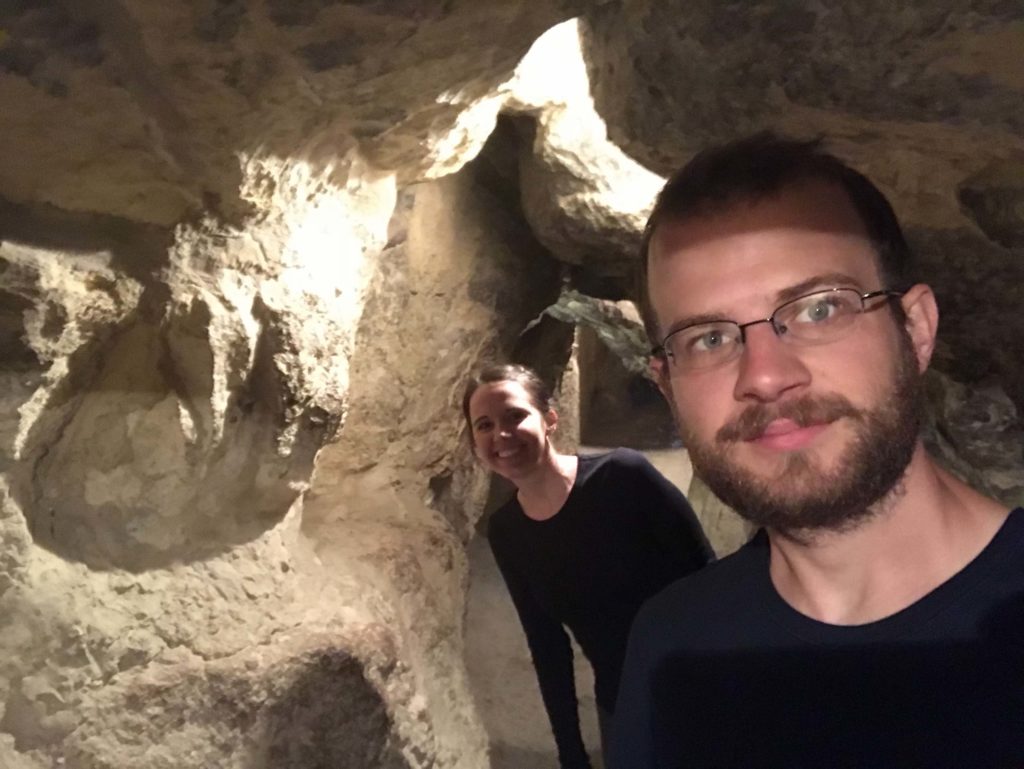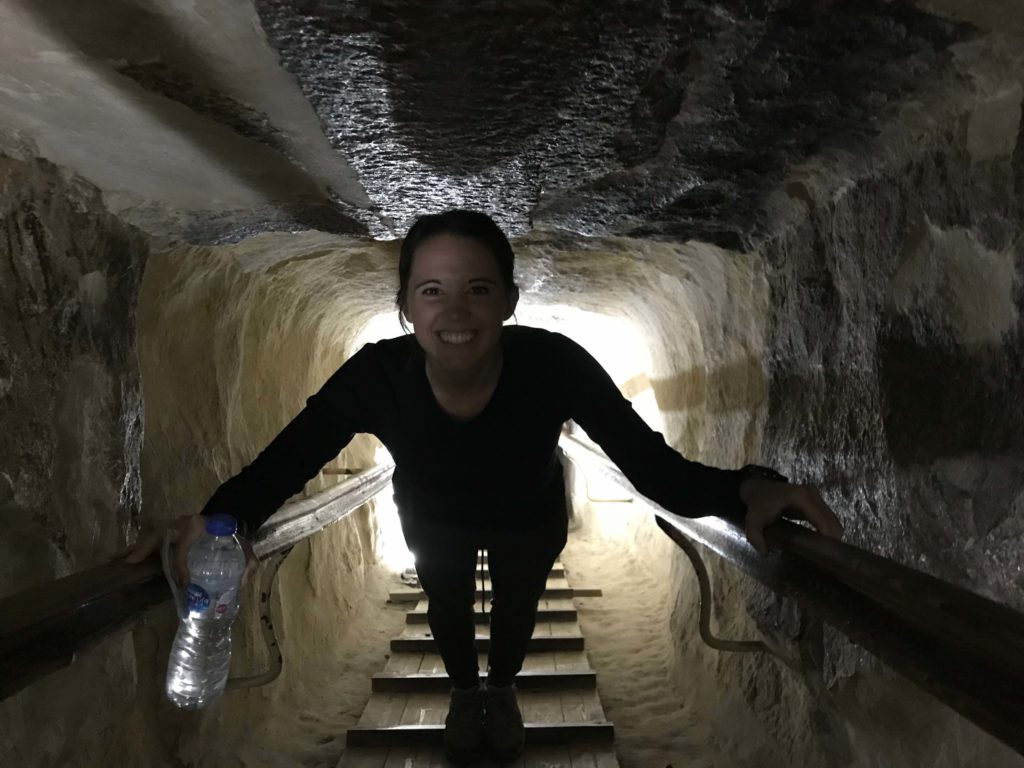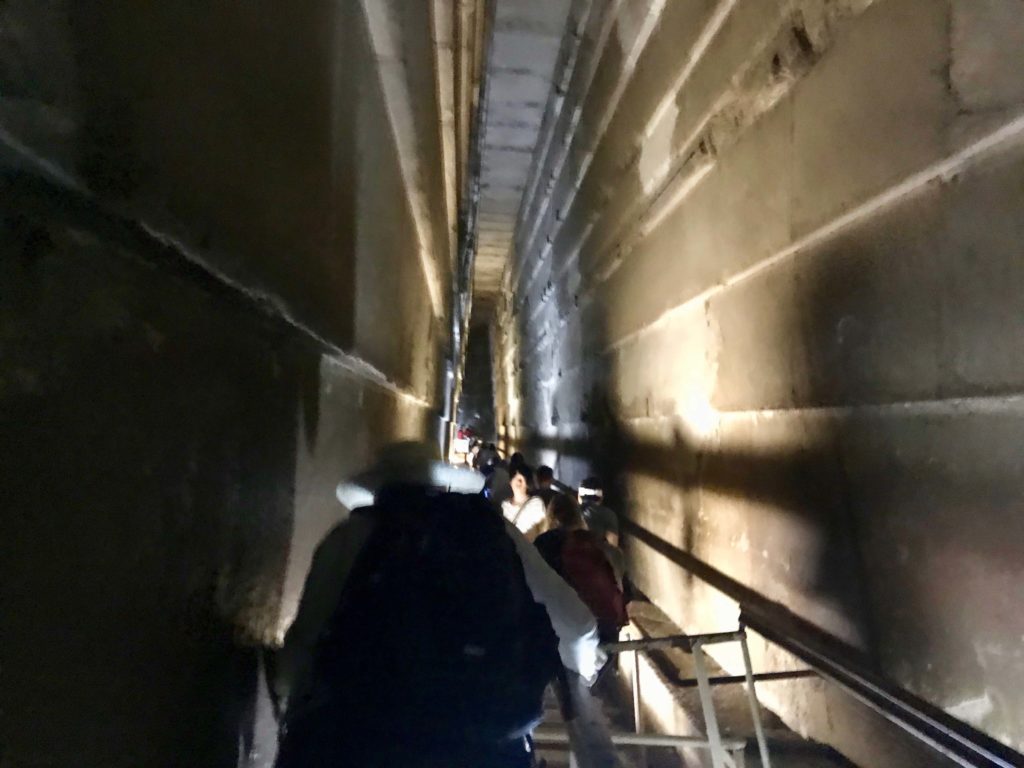Of the Seven Wonders of the Ancient World, the Great Pyramid of Giza is the only one still standing. An engineering marvel, a testament of human strength and ingenuity and a fascinating window into the Egyptian civilizations that ruled the land over 4,500 years ago. The Great Pyramid towers over the desert landscape of Giza. At 139 meters high, it was the tallest man-made structure in the world for over 4,000 years. The base of the pyramid covers over 592,000 square feet, comprises 2,300,000 stone blocks and weighs an estimated 5,955,000 tons. It’s truly a magnificent sight to see. In this post, we’ll explain our experience visiting the Great Pyramid of Giza with Emo Tours. Our tour also included Saqqara, Dahshur and Memphis, stops we consider essential on the pyramid route.
Great Pyramid of Giza by Tour or Independently
The Great Pyramid is located in Giza, a suburb/twin city to Cairo, making it very easy to get to using public transportation. You can get to the Pyramids on public transit by bus or train from central Cairo. This was our plan originally as we’re pretty comfortable on public transit and we try to avoid structured tours whenever possible. After doing some research though, we found that very few travel bloggers actually visited the pyramids on their own and there was very little information out there for taking a DIY tour. That’s kind of how Egypt is. It’s not very friendly to independent tourists.
Key Factors in our Decision
- We didn’t want to get scammed. There is no regulation around soliciting on the Giza Plateau. There is no official website and ticket pricing changes regularly. It’s not abundantly clear what your ticket includes, and the ticket sales people and the ticket collectors don’t seem to agree anyway. Tourists say they were charged to enter areas that should have been included in their ticket price, charged to walk down the public road to the viewing point and double charged for camels. We’re usually good at saying no to solicitors, but we were not interested in decoding what we really needed to pay for and what was a scam.
- We wanted to learn the history. Tour guides in Egypt are required to complete a four-year college program with a double major in Egyptology and Tourism. This means that your tour guide is going to be able to give you a lot of information about what you’re looking at and really bring the history to life. That was something we were really interested in. Without a guide, there is basically no information available at any of the sites.
- We were interested in seeing more sites than just Giza. Getting to the Giza Plateau on our own to see the pyramids and Sphinx was always possible via public transit, but we knew there was more than that. If we wanted to get to the other historical sites in the area, we knew getting a tour would be the most cost effective way to do it.
Based on these factors, we decided we would be better off visiting with a tour.
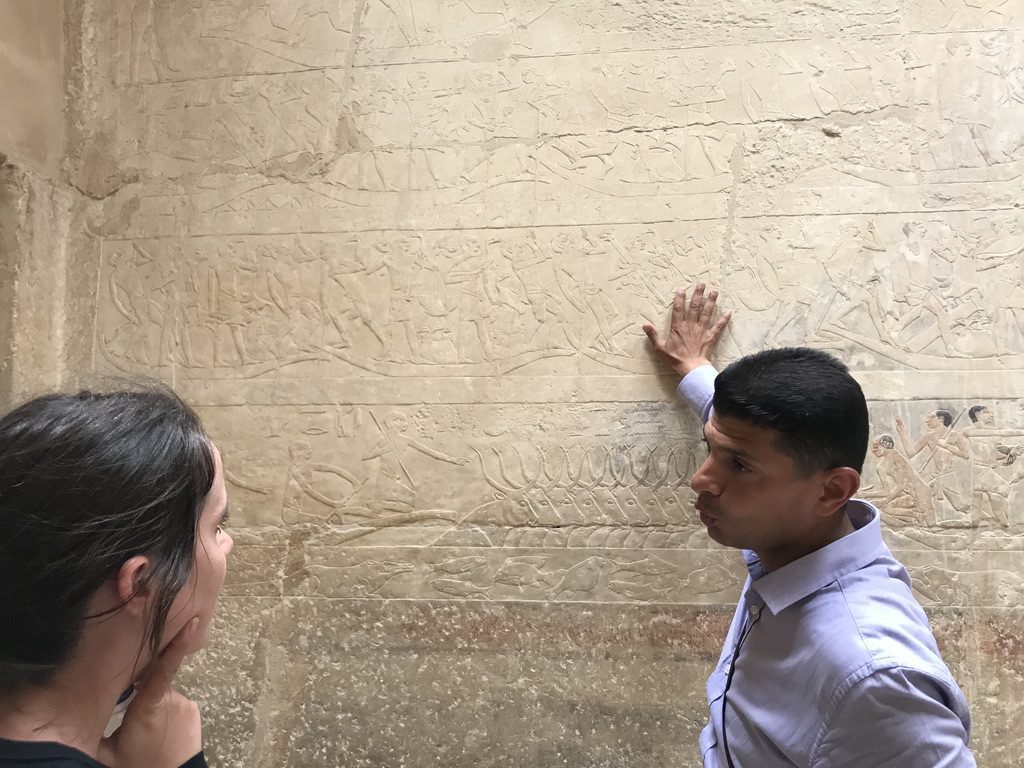
One of the reasons we choose to travel with a guide to see the Giza Pyramids and surrounding sights was so that we could learn about the history. Our guide did not disappoint.
Choosing our Tour to the Great Pyramid of Giza with Emo Tours
Once we had decided to take a tour, we had to pick one. We had previously booked a Nile river cruise using the #2 rated tour provider on TripAdvisor, Emo Tours. Even though we hadn’t actually taken the cruise yet, we still chose Emo Tours as our tour provider for the Cairo sites. We knew that the company was responsive, it was easy to book online and they received positive reviews for pyramid tours on TripAdvisor.
There are a lot of options when it comes to day trips, but there were three main contenders for us. All of the tour options are private, meaning that it is just your group, a driver, and a guide.
Top Tour Options to Visit Great Pyramid of Giza with Emo Tours
- Half Day Tour to Giza Pyramids & Sphinx: For only $20 USD (per person for a group of 2), this package includes transportation, private guide and main entry fees to the Giza Pyramids and Sphinx. Camel rides and entry into the Great Pyramid is an extra fee.
- Full Day Tour to Giza Pyramids & Sphinx, Memphis, Saqqara and Dahshur: In addition to everything listed in the half day tour, the full day includes two other burial sites (Saqqara and Doshur) and the ancient capital city of Memphis. The price jumps way up to $45 USD (per person for a group of 2), and includes entry into all the listed sites, a 15-minute camel ride and lunch. Entry into the Great Pyramid is an extra fee.
- Full Day Tour to Giza Pyramids & Sphinx + Cairo Activity: There are several packages that combine the pyramids with other sites in Cairo, like Old (Coptic) Cairo and Bazaar or Egyptian Museum and Bazaar. For $45 (per person for a group of 2), these options include transportation, private guide, entry fees and lunch.
We chose option two and would absolutely recommend this specific tour or a similar itinerary. Visiting all the sites together weaves together an incredible narrative of how ancient Egyptians began building pyramids and how the architecture evolved. The $25 extra dollars to upgrade from the half day tour was worth it considering it included lunch, a camel ride (if you choose) and three additional sights.
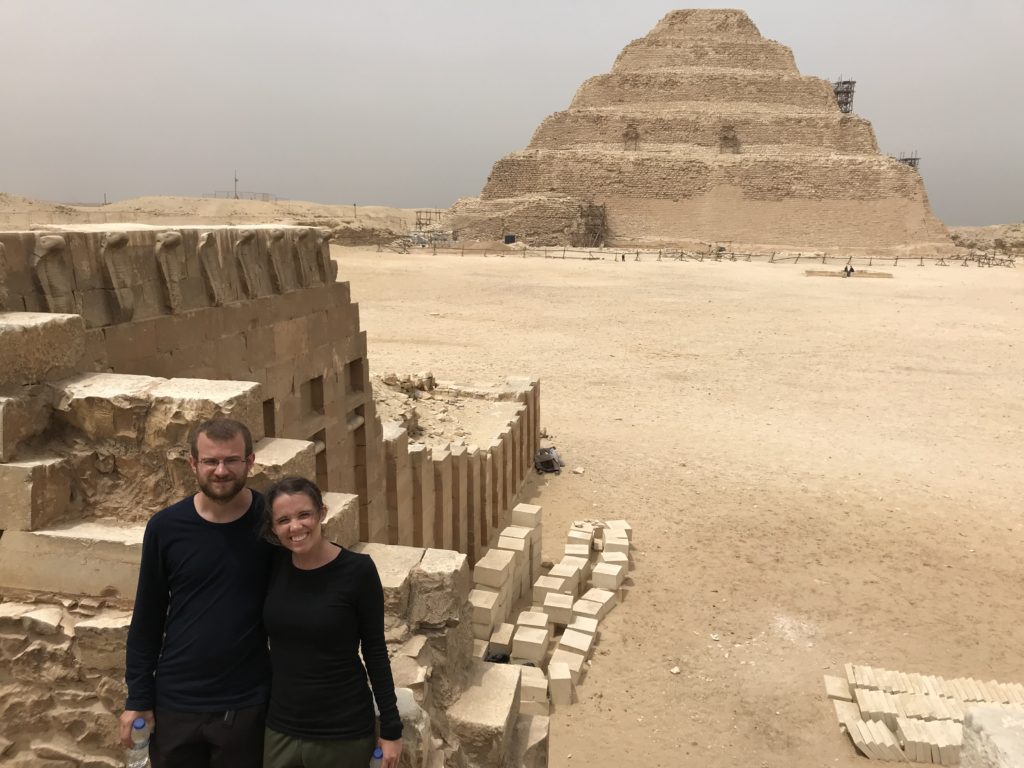
We highly recommend a tour that includes Saqqara and Dahshur for a complete story of the history of pyramid architecture
We visited Coptic Cairo, the bazaar and Egyptian Museum on separate days without a guide. You can easily visit the bazaar and Coptic Cairo on your own, but the Egyptian Museum has very little posted information. If you want to get anything out of it, you may want to consider a guide for that.
First Stop: Giza Plateau — Great Pyramid & Sphinx
Pick Up & Arrival at the Giza Plateau
We were promptly picked up at 7:30 AM and introduced to our guide and driver (two people). After two quick stops for snacks, water and coffee (included with the tour), we were on our way. During the 20 minute ride from central Cairo to Giza, our guide shared information about the cities, Nile and other bits of backstory before we arrived at the Giza Plateau.
If you have a romantic vision of the pyramids towering from the sand in the middle of the desert and you don’t want that vision ruined, I suggest you skip to the next section. The truth is that the pyramids are just a stone’s throw from Giza, a suburb of Cairo which is very much alive and well. You will absolutely find yourself stuck in traffic with pyramid views, which is not something I ever expected to experience.
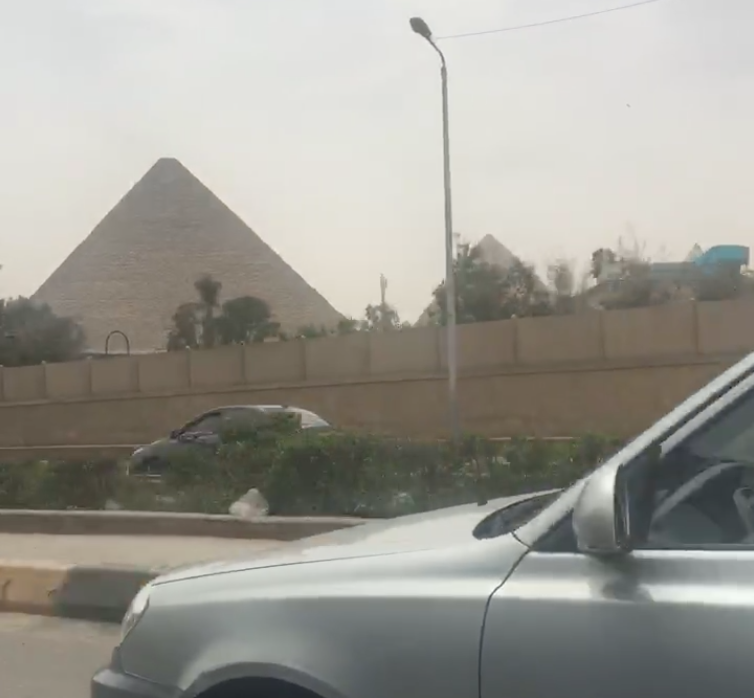
Our first glimpse of the pyramids was from the car as we sat in noisy and slow Giza traffic
Our driver brought us right to the entrance to the pyramid grounds and our guide purchased our tickets for us. We arrived at 8:30, and there was no line for tickets or entry. (I’m not sure Egypt has any lines for tourism these days).
The Great Pyramid
We spent most of our day at the Giza Plateau, and most of our time at the Giza Plateau was spent ogling the Great Pyramid of Giza. The behemoth structure is somehow even bigger than we imagined. With the blocks at the bottom nearly as tall as we were and the length of each side longer than two football fields, it was basically impressive by all accounts.
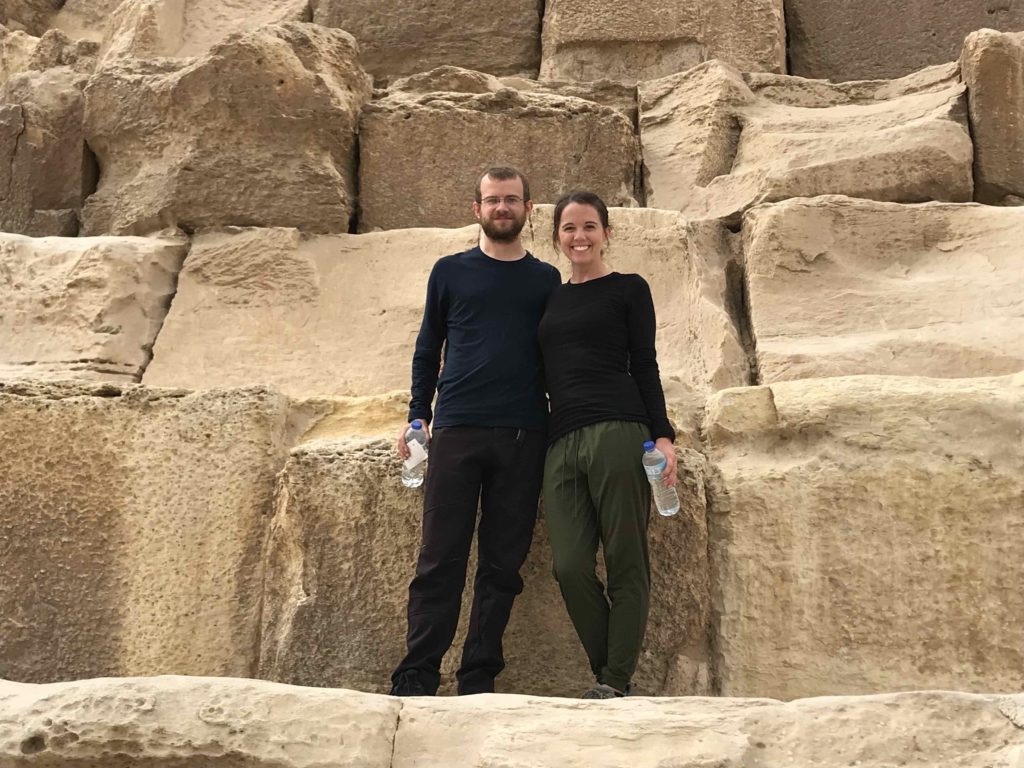
The limestone blocks that make up the pyramid are huge, weighing 2.5 tons on average.
Our guide said he was going to talk for five minutes, and then check with us on if we wanted to hear more. We were paying for his information, so we had no problem that he rambled for over a half hour. He was incredibly knowledgable and explained a lot of facts and history about the pyramid.
Going Inside the Great Pyramid
Going inside the Great Pyramid is an additional $22.50. We had already pre-booked this add-on with Emo Tours, and our guide secured our ticket at the gate. Before sending us inside on our own, he reminded us that photography is not allowed. He also said that if we told the guard that we don’t have a camera on our phone, that we can go in with our phone and sneak some pictures. We didn’t personally test out this theory, but plenty of people were sneaking photos inside without penalty.
The inside of the pyramid is a pretty notorious let down. It’s just a small, square marble room with an empty sarcophagus. I knew this in advance, but I still felt like I had to go inside. You can’t come to the pyramids and not go inside! Don’t expect anything mind blowing, but don’t skip it.
What is it like going into the Great Pyramid?
I was very nervous about going inside the Great Pyramid. Even though I desperately wanted to go inside, there was so much hype about how narrow the passageway was. I had recently been to Cu Chi Tunnels in Vietnam and didn’t make it 10 meters before having a panic attach, so when I heard “small spaces” and “no easy exit”, my heart started beating out of my chest. The truth is that I didn’t think it was that bad at all, especially compared to the Cu Chi Tunnels.
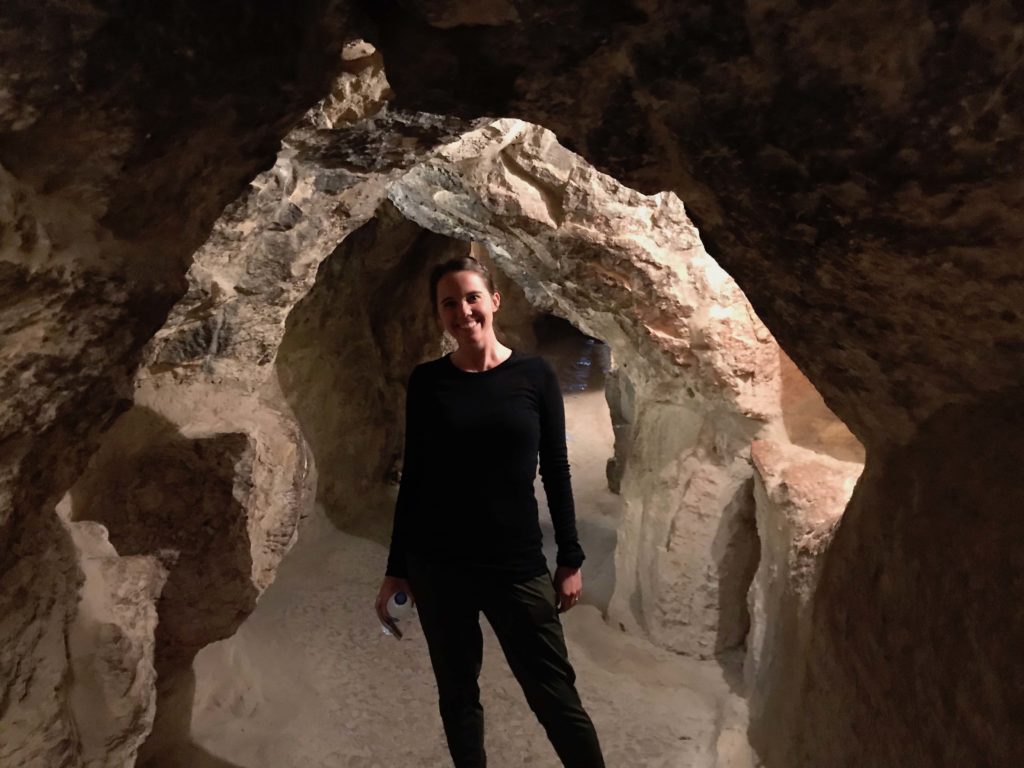
Making our way through the first corridor into the Great Pyramid. Fact: this is about 100x bigger than any part of the Cu Chi Tunnels.
We are fairly small people and didn’t have any issues with the size of the tunnels leading into the burial chamber. Despite what I’d read, you can turn around and exit at anytime, as the entire route is two way. We witnessed people of all shapes, sizes, ages and fitness levels making the journey. If you’re super claustrophobic, I can see this being an issue, but if you’re just borderline and have a bit of determination, I think you’ll be fine.
Getting Inside the Great Pyramid Goes Something Like This
- Show the guard your ticket at the giant whole in the north side of the pyramid, and he’ll let you in.
- Walk through a short corridor of reasonable height and width (2 minutes).

The first corridor has plenty of space to stand and walk, even with people coming from both directions.
- Climb up a narrow ramp, sloped at about 45 degrees for about 40 meters (about 5 minutes).
- This is the worst part.
- The tunnel is probably only about 4 feet high, and lined with handrails and boards for steps.
- There is not enough room to stand, but you do have plenty of room to extend your body lengthwise, so you’re not crouching.
- The passage is two way, which makes it a bit tighter if people are coming down at the same time you’re going up.

The view from inside the narrow sloped tunnel leading into the pyramid. You can see that it’s narrow for two-way traffic and too short to stand, but still room to elongate your body leading forward.
- Climb another set of steep stairs for about 30 feet (3 minutes).

Bad photo, but here you can see the narrow set of steep steps leading you the final vertical leg toward the burial chamber. There is actually two sides for most of this section, one for each direction of traffic.
- Crouch through a final small tunnel about 4 feet high and about 8 feet long (<1 minute)
- Arrive inside the burial chamber! The center has plenty of space to stand up and walk around around before you make your way back down.
Riding the Camels
Included with our tour was a 15 minute camel ride around the Great Pyramid. We had already decided this was not something we were interested in supporting, and politely declined. Our guide tried to push us a little bit, but we insisted on not participating in this part of the tour.
You can decide for yourself how you feel about riding the camels. We have read the camels, specifically the ones for hire on the Giza Plateau, are not treated well. It is possible to arrange a camel ride from a private, reputable stable, but we didn’t trust that we would be getting that. We also know that the cameleers are master scammers who will overcharge tourists, charge tourists twice or require a tip to make their camel actually move. We could not support these practices by taking the camel ride, even if it was included.
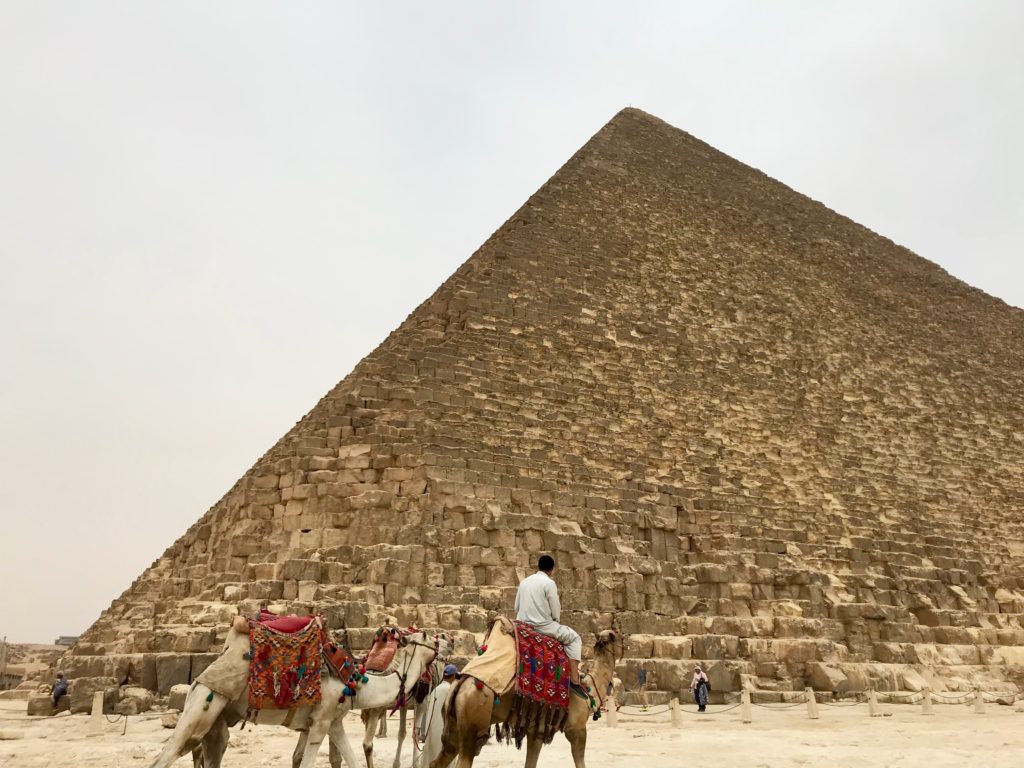
The Giza Plateau is filled with cameleers pedaling their animals.
Solar Boat Musuem
Our tour guide promised us lots of “surprises” to delight us throughout our tour. His surprises were bonus stops which were not listed as part of the tour, but that he chose to add and pay for. Most of these surprises were small and did not likely cost additional money, but I’m sure it’s a great technique to help him and the company stand out
The Solar Boat Museum was his first surprise. He told us about this crazy practice of the Egyptians where they built these really huge, really elaborate, really perfect boats … and then they dismantled them and buried them outside the pyramid. The idea was that when the king became a God, he could use his God magic to put the boat back together and sail onto the after life. (I paraphrase, but something like that.)
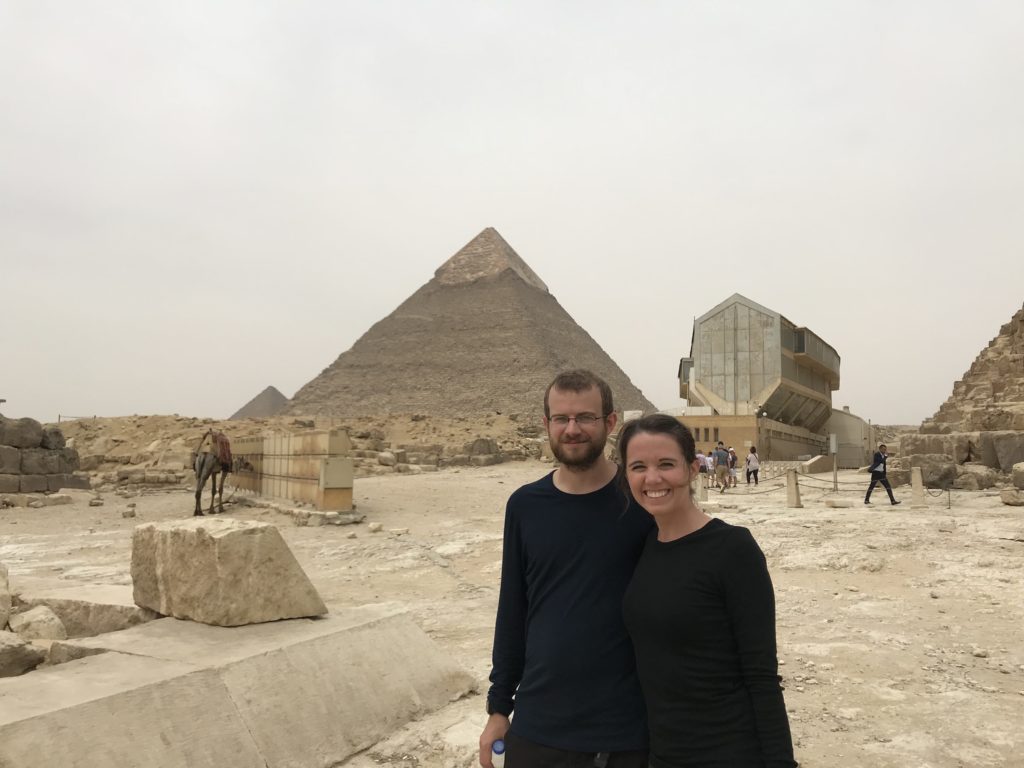
The Solar Boat Museum is located just south of the Great Pyramid. Our guide made sure we had a photo with the museum on the outside, since we couldn’t take any photos inside.
The Solar Boat Museum museum is built directly above the location where they found the boat pieces, just south of the Great Pyramid. The museum houses the reconstructed boat using the original 1224 pieces found buried there. This was one of the most impressive parts of the tour. I had no idea about this part of Egyptian history, and it was really quite fascinating. I’d definitely recommend working this into your visit if possible.
Panoramic Viewing Area
Passing behind the pyramids to the west is a gravel road that will lead you to the panoramic viewing area. Our driver picked us up from the Solar Boat Museum, drove us up the road, and then parked on the far west side of the area (to the right if you’re coming from the pyramids).
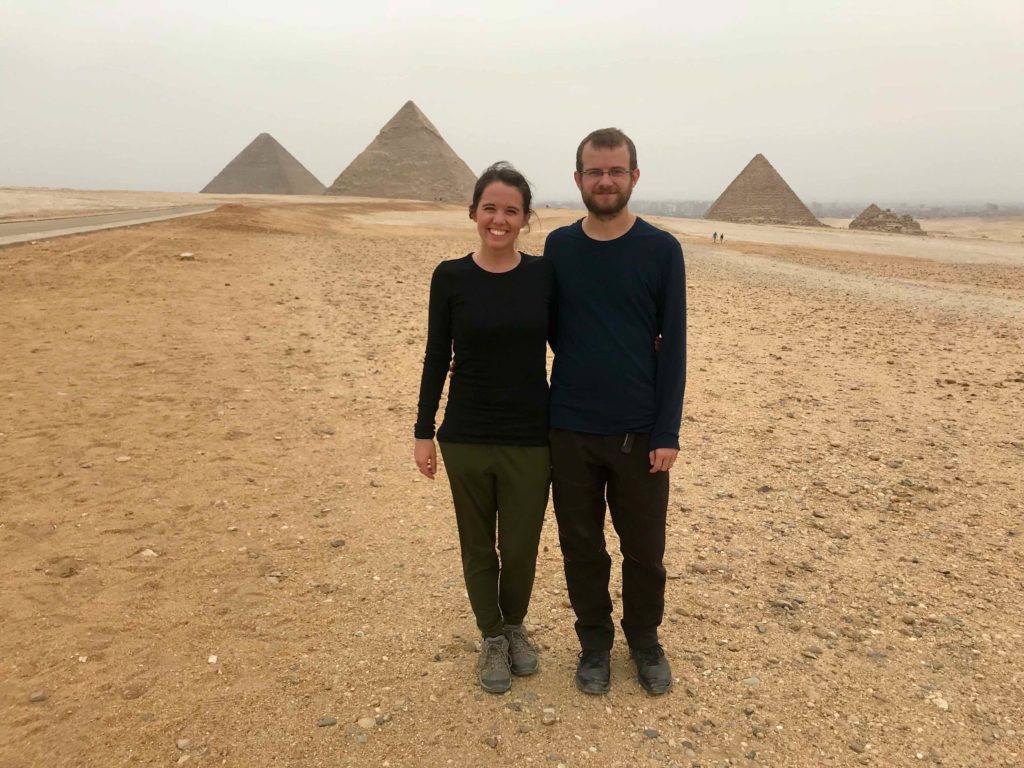
To the left of this photo, you can see the road that leads up to the viewing area. To the right of this photo (not pictured), are several tour buses and many people taking photos.
At roughly 10 AM on a Saturday, the viewing area was pretty crowded with tourists and several tour buses. Our guide kept us a good distance away so we were able to get photos alone. This was where we realized just how into photos our guide was; he took about a hundred.
The view from here was good, but it’s not the classic postcard view that showcases all three large pyramids and the three smaller pyramids. To get that postcard view, you would have to take a camel or horse much further east into the dessert as there was no way to drive there. I understand why we couldn’t do this on our tour, but I was still disappointed.
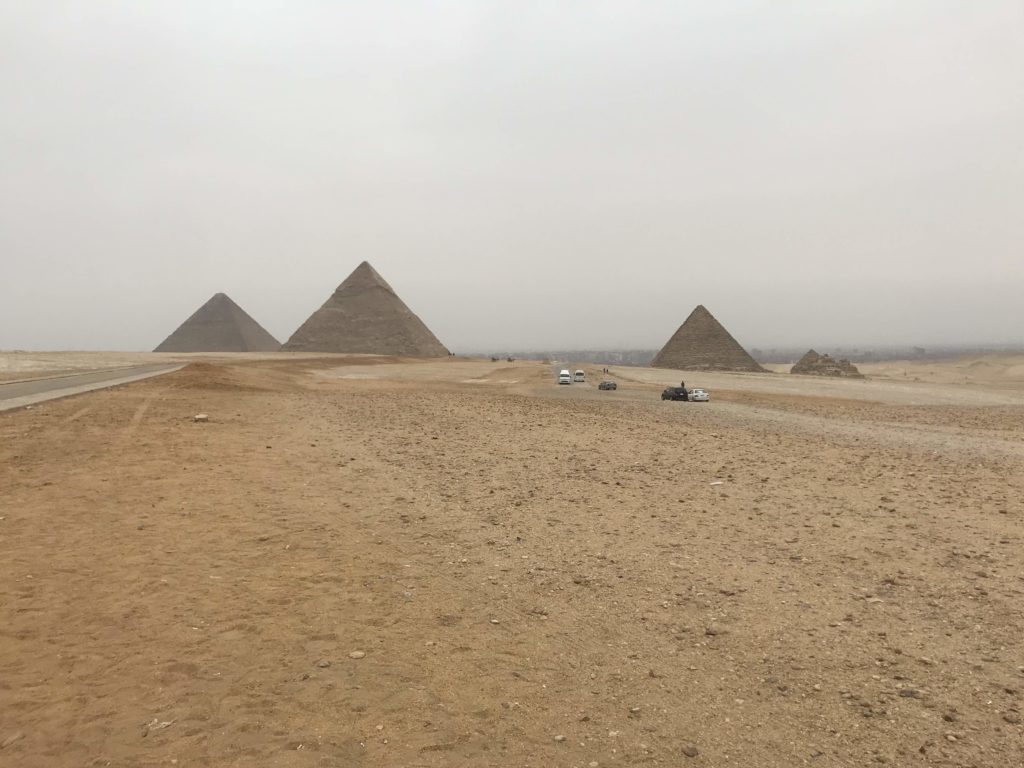
Our best view of the pyramids from the panoramic viewpoint.
If you’re set on getting this picture, talk to your guide. Our guide was very flexible and always asking if there was anything different or extra we wanted to do. I presume that if you expressed disappointment, he/she would be able to get you over there.
The Sphinx
To get to the Sphinx from the view point, we hopped back in the car and drove for about five minutes. The plateau is actually quite large. The Sphinx is close to the pyramids, but not as close as you think and definitely not walkable.
There was another ticket booth, and our guide had already arranged our ticket. I’m honestly not sure if this was all included on one ticket or if separate tickets were required. Our guide took care of those details. Once inside the area, he explained the structure, the building of the Sphinx and how it has been covered and uncovered by sand numerous times over its history.
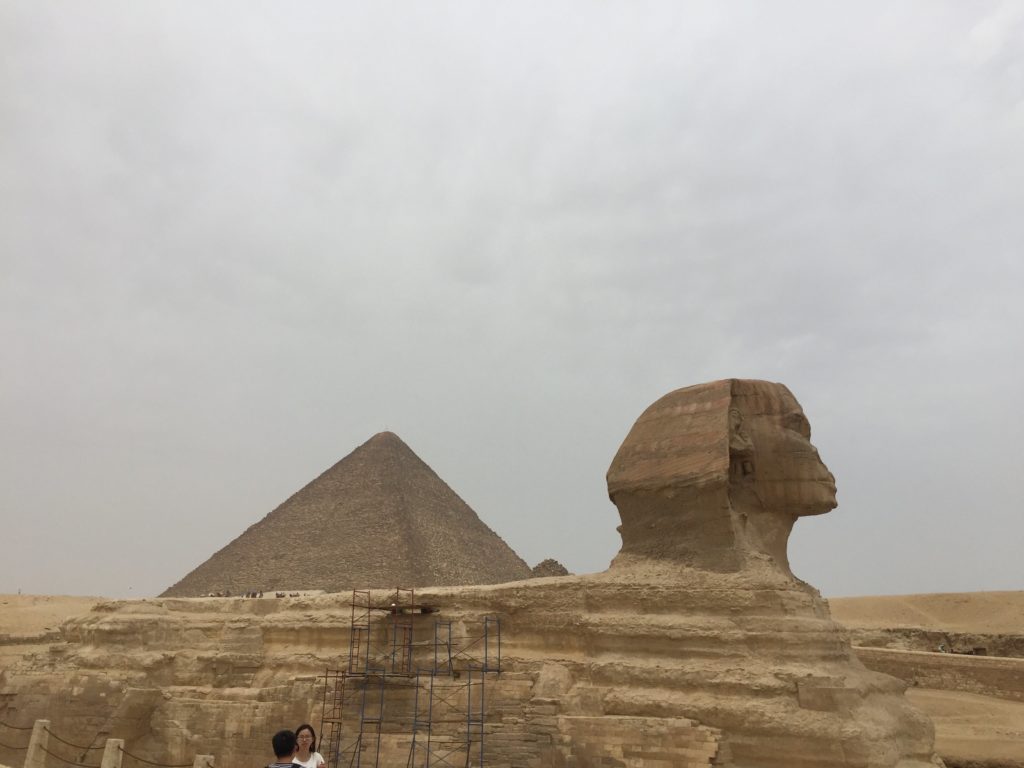
The main viewing area for the Sphinx is actually to the side. This makes for a great profile and cheesy trick photos, but not the head-on shot we craved.
The Sphinx narrative was quite interesting, but the Sphinx itself was a little anticlimactic to me. It was nowhere near as big as I pictured. The viewing area is also awkwardly located on the side of the Sphinx. So again, you can’t get the classic postcard photo with the towering Sphinx with the pyramids in the background.

Look how tiny the Sphinx looks! The only way to see the Sphinx head-on is from outside the gate, which is pretty far from the actual Sphinx.
Second Stop: Lunch Break
It was about 11 AM when we left the Giza Plateau. Our guide asked if we were ready for lunch, and we weren’t because we’d been forced to eat the snacks he got us for breakfast. After some discussion, it sounded like eating in Cairo was the most practical option, so we went with it.
We had requested a vegetarian meal when we booked our tour. Our guide took us to a small local restaurant where he introduced us to the Egyptian dish of Koshari. This dish is made up of spaghetti, macaroni, lentils, and fried onions, all topped with a spiced tomato sauce, garlic vinegar, and a spicy chili sauce. It was really delicious and was probably Kenny’s favorite part of the day.
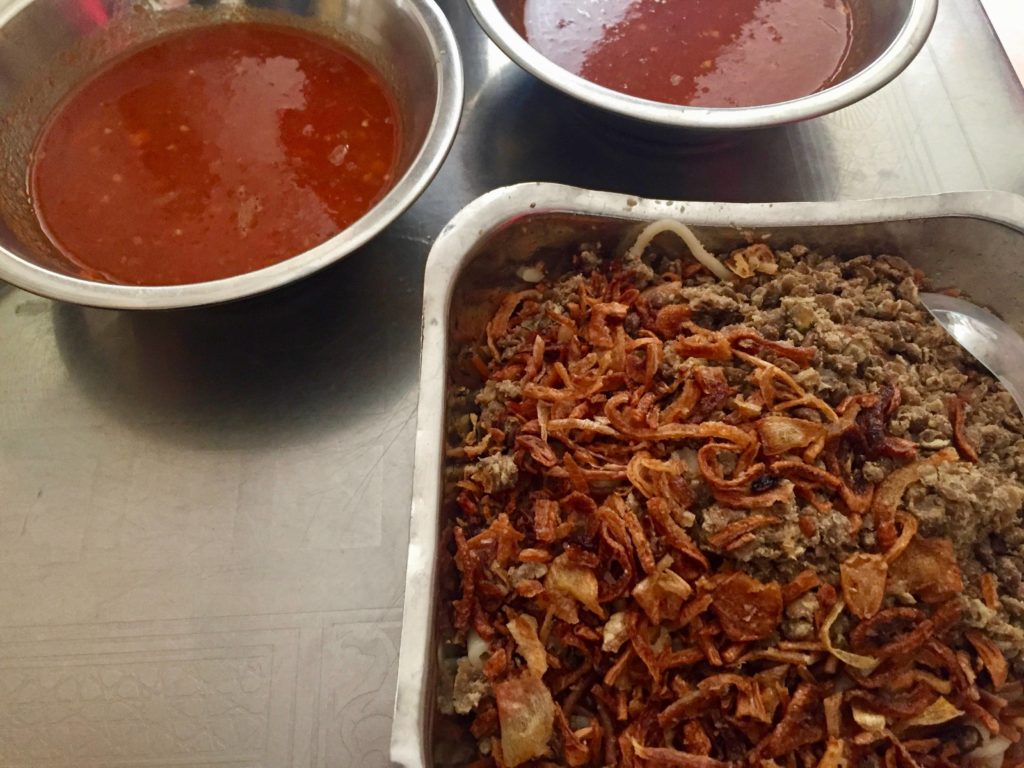
This doesn’t look like much, but this mess of pasta, lentils, fried onions and sauce is a super delicious and super filling Egyptian vegetarian lunch.
Third Stop: Saqqara — Step Pyramid
About an hour drive from Giza Plateau is another ancient burial ground, Saqqara. This necropolis is home to the Step Pyramid of Djoser, as well as several other tombs, pyramids and ruins. The Step Pyramid was the first pyramid structure of the ancient Egyptians and was the first step in the development of pyramid architecture. Our guide shared a ton of great history about the Step Pyramid and complex. This helped shaped our understanding of the ancient Egyptians for the rest of our time in the country.
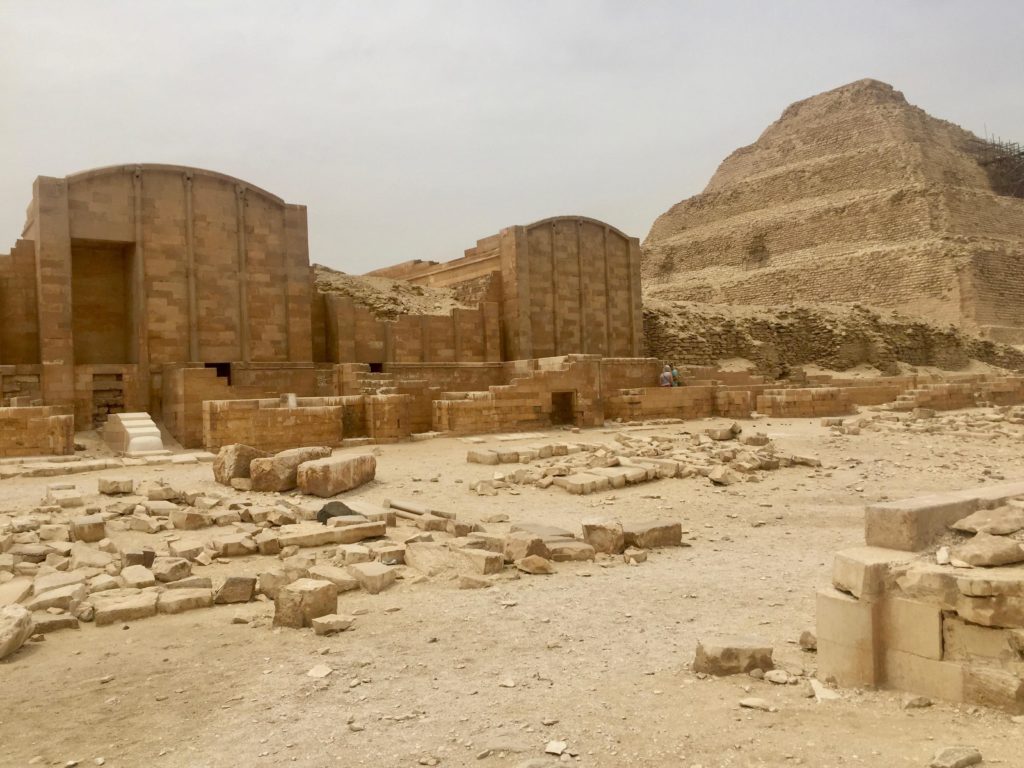
The Step Pyramid at Saqqara and the surrounding complex was filled with great history.
Another one of our guide’s surprises was to take us inside the tomb of princess Idut. Just like our guide’s surprise addition of the Solar Boat Museum, this was another really great surprise. He took us inside the tomb which comprised several small rooms. The walls in each room were covered with original hieroglyphics and art work. Many of the paintings even had original coloring still clearly visible. This was really incredible.
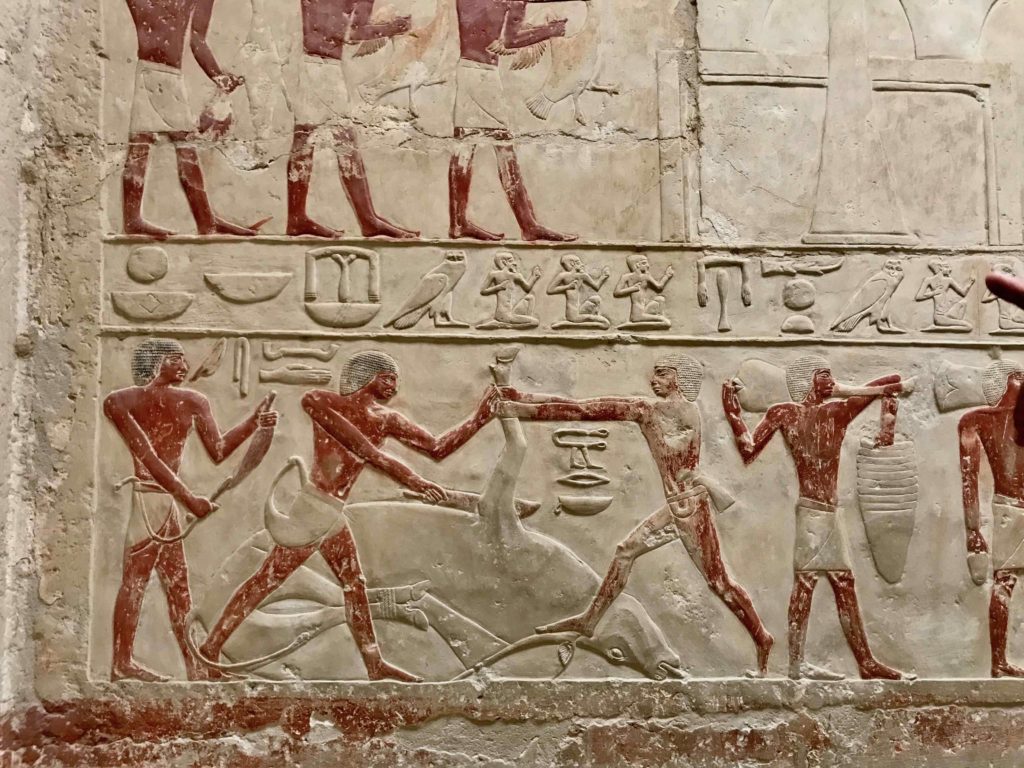
The carved and painted walls inside the tomb of princess Idut was incredible.
Unfortunately, Saqqara feels like one of the places that was hit particularly hard by Egypt’s tourism slump. The grounds were fascinating and beautiful, but they were nearly empty. We felt bad for the people selling souvenirs to the handful of tourists who mostly just kept walking.
Our guide asked if we wanted to buy anything, but did not pressure us at all. He let us know that he knew the people there and they were good people. Just like anywhere, there are good people and bad people, and we did appreciate that he would have helped us buy souvenirs from the right people. We did not purchase anything and that was no problem. If you do plan to do some shopping, your guide will be able to connect you to the right people.
Fourth Stop: Dahshur — Bent Pyramid & Red Pyramid
We hopped back in the car and drove about 20 minutes to our final necropolis — Dahshur. Here we discovered two more pyramids that were essential to the development of the architecture of the Great Pyramid.
After the success of the step pyramid of Saqqara, the Bent Pyramid was the first attempt at building a pyramid with straight sloped edges. Unfortunately, they failed. Halfway through building it, they discovered their angles were wrong and the pyramid could not stand. After changing the slope, they were able to finish construction, but not without the very obvious bend in it.
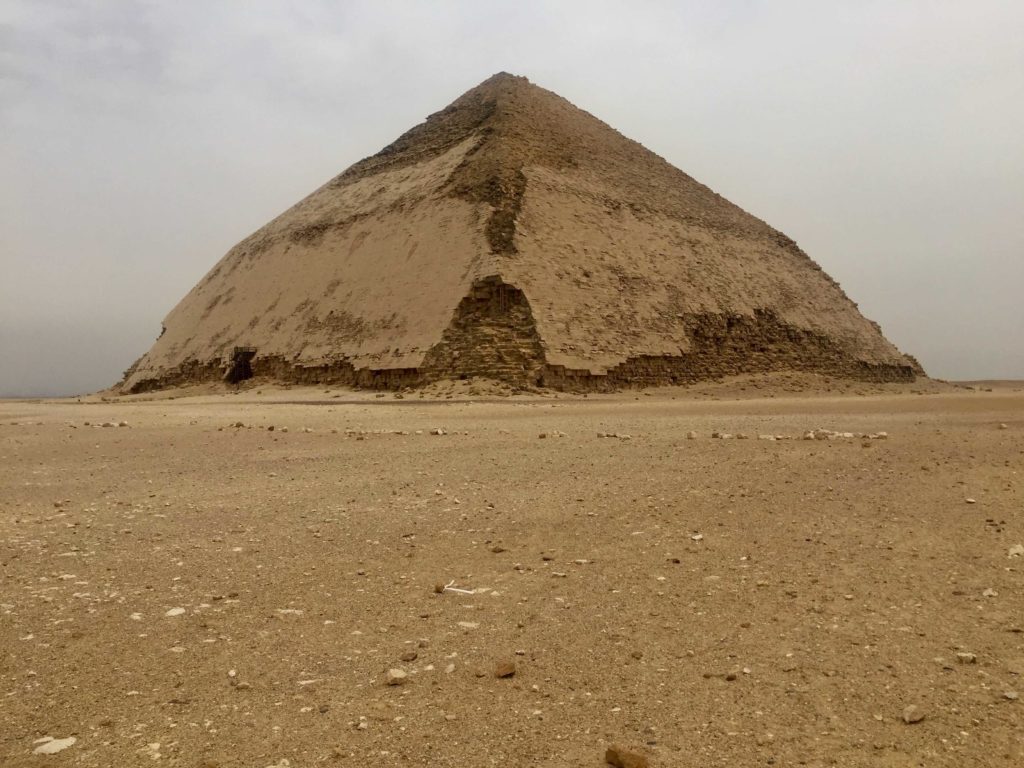
Womp womp.
Right across from the Bent Pyramid is the Red Pyramid. It was the first successful pyramid ever built. You can go inside the Red Pyramid, but apparently it is a lot more work and takes a lot longer than going inside the Great Pyramid. We did not go inside this pyramid.
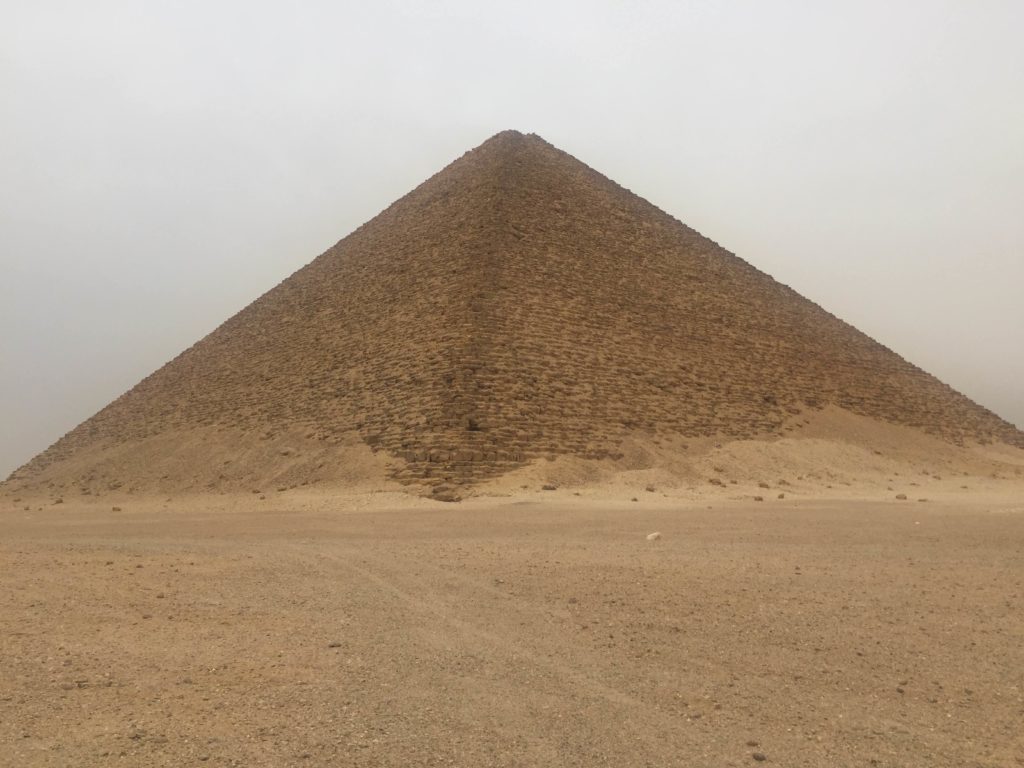
They did it! The first smooth side pyramid was completed in 2590 BCE.
The chronology of pyramid architecture was fascinating, and to be able to see all of these pyramids still standing to outline the development is truly an incredible thing to see.
Fifth Stop: Memphis
Getting to Memphis was more exciting than Memphis itself. It’s another 20 minutes away from Dahshur, and the drive takes you through some beautiful farms and small towns. It also takes you along a river where the banks are literally entirely made of trash.
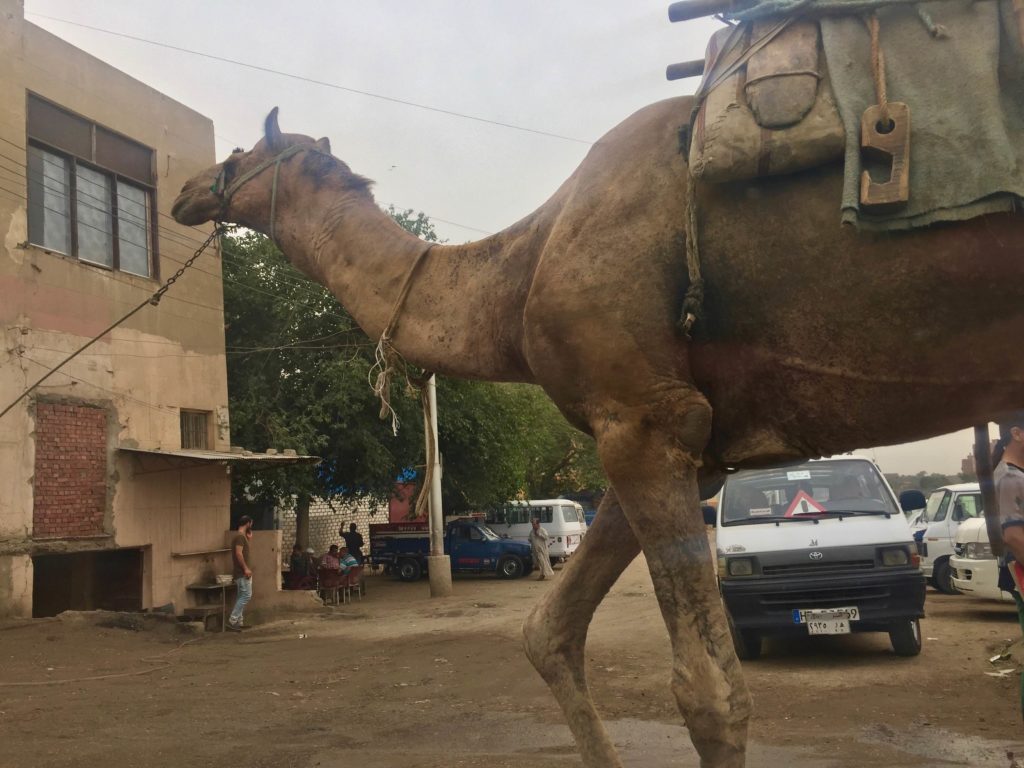
Camel Traffic in Memphis
There was seriously so much trash. At one point, our driver was pointing something out and all we saw was a bunch of trash. His response was, “Don’t look at the trash. The trash is not our fault.” I have no idea what he meant by that, but that kind of sums up how I feel about the tourism industry in Egypt. Everything is crumbling around them and all they have to say about it is that it’s not their fault.
Memphis is the ancient capital of Egypt, which makes it sound really cool. All there is to see now is an open-air statue museum. The first thing we saw was the giant statue of Ramesses II. This is impressive, but the only thing really worth seeing. Our guide walked us through a few other statues, but we were done in about 20 minutes.
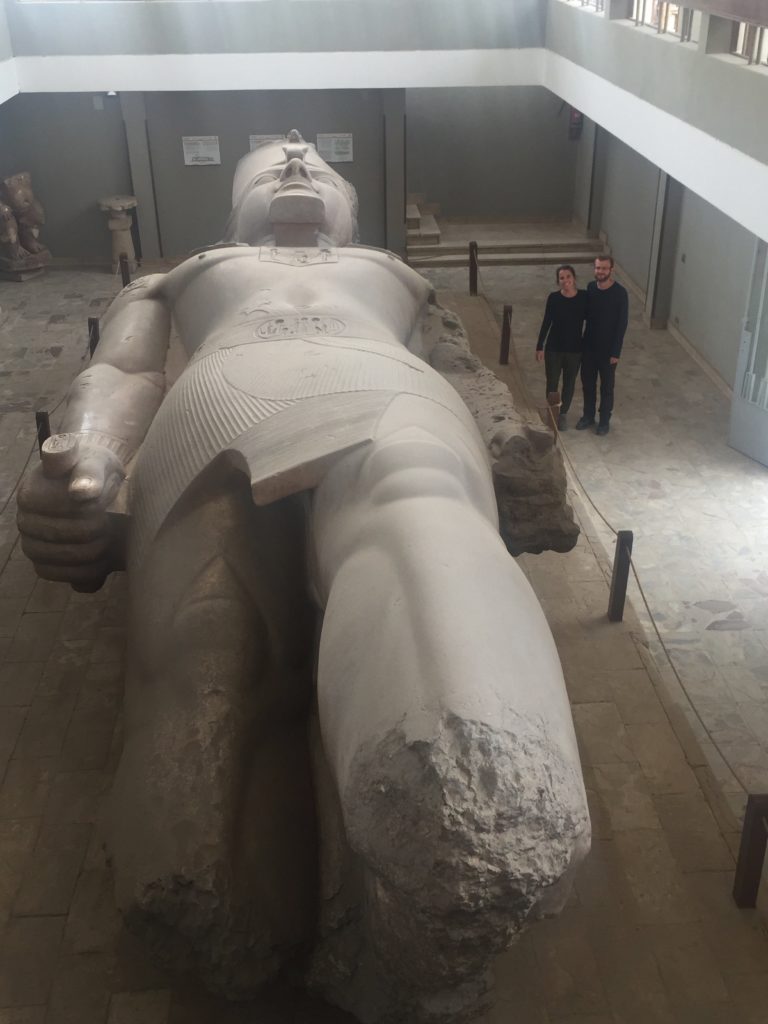
The gigantic statue of Ramesses II is the best part of Memphis. Humans for scale.
Closing out our day
After wrapping up at Memphis, our guide sat us down to debrief on the day. He asked if we were happy, if there was anything else we wanted to do, and if we could please review him on TripAdvisor. He asked if we wanted to book any other tours with him, we said no thank you, and he did not press the subject.
Just outside Memphis, our guide said he needed to stop for one final surprise. He jumped out of the car and came back with three tall, cold glasses of fresh sugar cane juice. Another great surprise and final touch.
We drove the hour back home to Cairo, while our guide shared a final bit of knowledge with us about the historical names of Egypt. Traffic was bad in Cairo when we returned, so a few blocks from our hostel we offered to jump out and walk the rest of the way. Our guide jumped out with us and insisted on walking us all the way back to our hostel. It was not necessary, but we appreciate the customer service.
Looking Back on our Tour to the Great Pyramid of Giza with Emo Tours
Feedback on Emo Tours — The Good
Overall, we were happy with our decision to book the full day tour to the Great Pyramid of Giza with Emo Tours with stops at Memphis, Saqqara and Dahshur. We found our guide to be chock-full of information and we learned more than we expected. We definitely would not have learned as much or had as enjoyable of a time if we did not have an Egyptologist like our guide with us throughout the day. It was also very relaxing to have all of our tickets and fees taken care of for us.
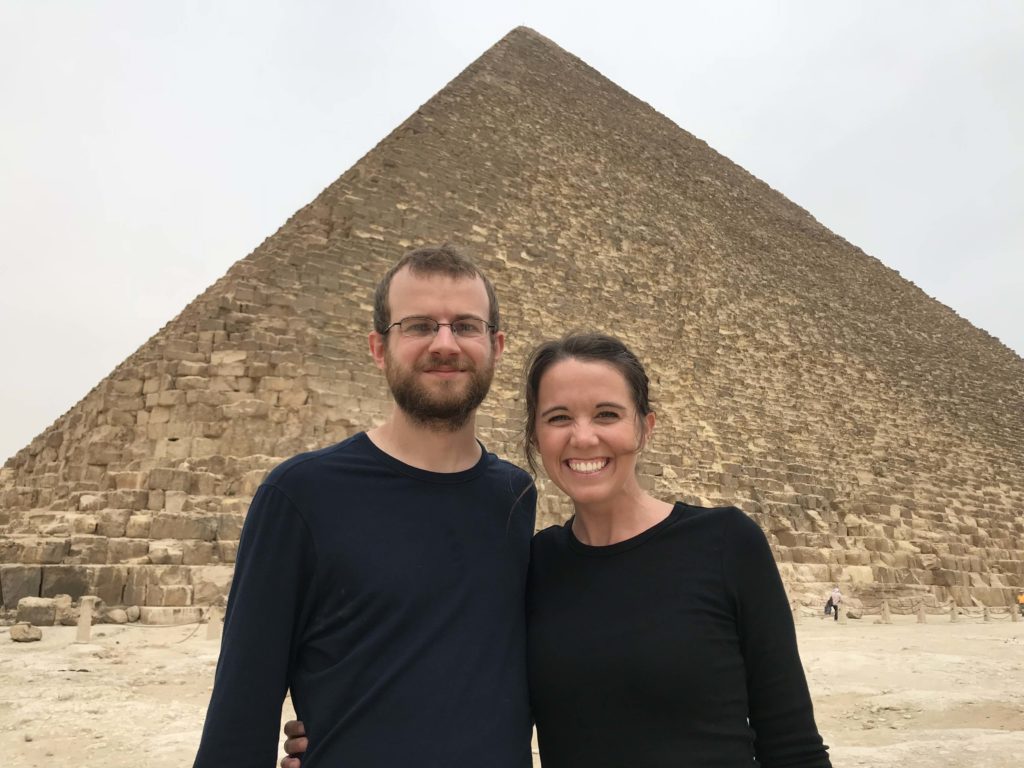
Thank you Emo Tours for our great day exploring the ancient Egyptian sites around Cairo.
The tour was very flexible. If you had any interest in making adjustments or adding stops, you certainly could have. Definitely communicate with your guide about what you want and don’t want to do. Our guide offered to take us to the papyrus museum and a carpet museum. We weren’t interested in either, and that was completely fine. If you were interested in adding these stops or others, you certainly could.
Feedback on Emo Tours — The Not So Good
We were really frustrated with our guide’s photography. We did appreciate that our guide was always willing to take pictures, but he was a little obsessive. He made us take way more photos than we ever could possibly need or want. It was distracting to constantly be stopping to take photos that we knew weren’t going to make the photo book.
Even more annoying than that, he wouldn’t let us take our own photos. He always insisted on taking photos for us, which was frustrating because many of his photos were honestly not that good. He did a lot of the trick shots, but did a terrible job lining them up. I wish he would have just let Kenny take the photos we wanted when we asked.
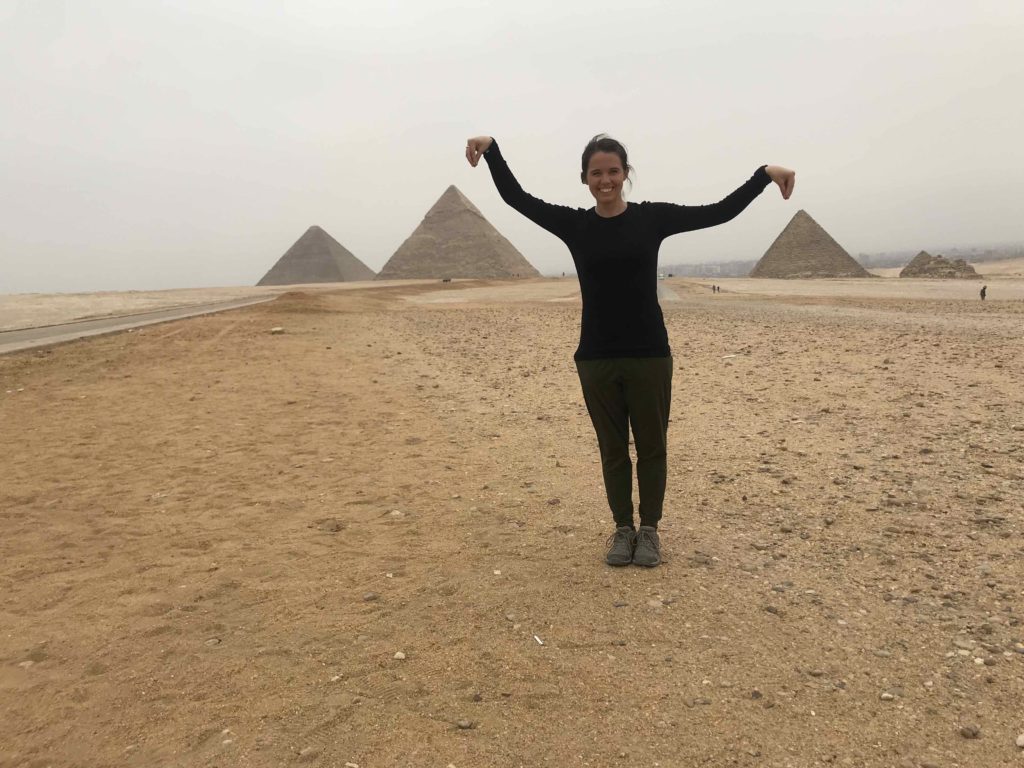
This was supposed to look like I’m picking up the pyramids … but our guide didn’t get my hands even close to the pyramid peaks.
The other thing our guide kind of missed was the narrative. There was clearly a beautiful story around the evolution of the pyramid architecture. Our guide was so focused on the facts and the people that he missed the central thread of the story that wove the day together. A better storyteller would have really made this tour great.
Tipping
Tips are not included in the tour price, but they are expected. This is true anywhere, but you definitely can’t do anything in Egypt without tipping. Kenny did a little bit of research on the matter from the car. It seemed like suggested tips ranged from 50-75 EGP for the driver and 100-150 EGP for the guide. We decided to tip our driver 100 EGP ($5.67 USD) and our guide 200 EGP ($11.34 USD). We think this was on the higher side, but for less that $17 USD total, we were happy to do it.
Closing thoughts on our visit to the Great Pyramid of Giza with Emo Tours
If we had to do it all over again, we still would have chosen Emo Tours and we still would have chosen the full day option. We probably would have requested to skip Memphis and used the time trying to get to a better vantage point of the Great Pyramid. I would also try to be more insistent with our guide about taking our own photos. But other than that, we were really happy with our experience learning about ancient Egypt and exploring the sights around Cairo.
Generally speaking, we found the tourism environment in Egypt frustrating. Between the scams and the lack of regulation, it is nearly impossible to visit without a tour. It’s not just that we needed a tour, it’s that nearly all of the tours are private tours. Kenny and I just aren’t that talkative and find private tours exhausting. We strongly prefer group tours that don’t require us to chat all day. However, those are things we cannot change.
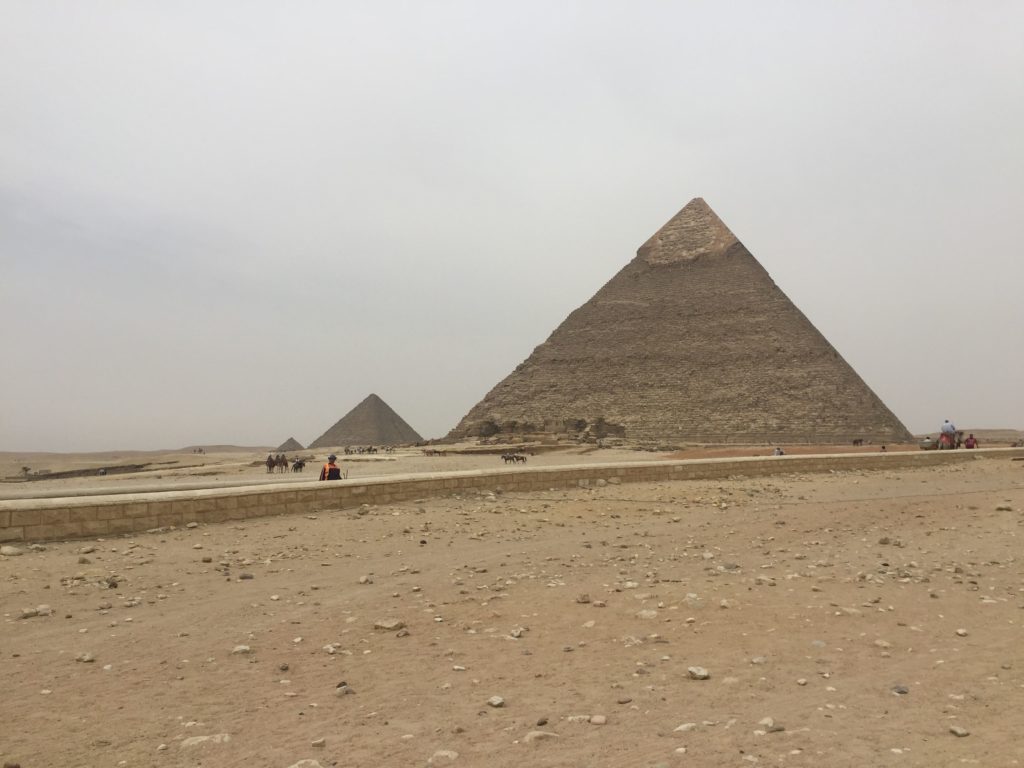
Visiting the pyramids of Giza was an unforgettable experience that definitely belongs on your bucket list.
Have you been to the Great Pyramid of Giza? Did you visit on your own or take a tour? Share any tips in the comment section below.

